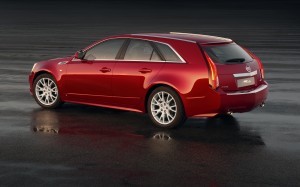
Leasing is particularly critical in the luxury segment where Cadillac is just introducing two new models.
General Motors Company has turned away from its preferred lender, GMAC Incorporated, and expanded its financing options for prospective buyers by turning to leases written by U.S. Bank. The leases are part of a pilot program that includes select GM vehicles sold in New York, New Jersey, Connecticut, Michigan and Ohio.
In addition, a lease on the all-new Cadillac SRX will be offered by U.S. Bank nationally. The pilot is currently planned to run through August 31, 2009, but will likely be extended if it works.
“GM and our dealers have done an incredible job without a leasing program throughout this difficult economic period, but we always knew that we would get back into leasing as it is important to a certain group of our customers,” said Mark LaNeve, GM vice president of U.S. sales.
GM dropped leasing one year ago when resale values plummeted, forcing a write-down by the finance company GMAC of the value of the vehicles coming off lease. Before dropping leasing, an estimated 25% of the sales of GM vehicles were accomplished by the financial device that allows lower monthly payments and use of a vehicle for a limited time compared to an outright purchase.
LaNeve estimated that the lack of leasing has cost GM one to two percentage points of market share, at a time when the company must prove it can halt its decades’ long decline in share, which is currently running at about 18%. Leasing is particularly critical in the luxury segment where Cadillac is just introducing two new models, SRX and CTS Sport Wagon.
Lease offers will be available on the 2009 Cadillac CTS, Chevrolet Malibu and Traverse. For 2010 models, leases will also be available on the Cadillac SRX, Buick LaCrosse and Enclave, the GMC Acadia and the Chevrolet Equinox. Monthly payments will vary, according to the customer’s down payment and the first month’s payment due at signing, but are expected to be “very competitive.” No security deposit will be required.
U.S. Bancorp (NYSE: USB), with $266 billion in assets, is the parent company of U.S. Bank, the 6th largest commercial bank in the United States.
GMAC itself remains severely challenged, as it continues to report huge losses because of loan defaults and the depressed housing and auto markets. In the second quarter of 2009 GMAC posted $3.9 billion loss compared to a net loss of $2.5 billion in the second quarter of 2008. Results included a $1.2 billion tax charge caused by converting to the financial holding company to a corporation. To date, GMAC Incorporated has accepted $13.5 billion in U.S. taxpayer funding. The government has a 35% stake.
|
GMAC Incorporated Financial Results ($ in millions) |
|||||
| Q2 09 | Q2 08 | ||||
| Net Income/ (Loss) |
Incorporation Impact |
Other Taxes |
Pretax Income/ (Loss) |
Pretax Income/ (Loss) |
|
| Global Automotive Finance | ($727) | ($1,051) | ($22) | $346 | ($709) |
| Insurance | (515) | 1 | (40) | (476) | 193 |
| Mortgage Operations | (1,836) | 71 | 137 | (2,044) | (1,761) |
| Corporate and Other (1) | (825) | (234) | 25 | (616) | (32) |
| Consolidated | ($3,903) | ($1,213) | $100 | ($2,790) | ($2,309) |
| (1) Includes Commercial Finance, equity investments and other corporate activities | |||||
In June 2009, GMAC LLC was converted from a partnership into a Delaware corporation and renamed GMAC Inc. The conversion enabled GMAC to create a more flexible capital structure, facilitate implementation of the registration rights provided to GMAC common and certain of the preferred shareholders, and eliminate the requirement of dividend payments to certain equity holders to cover GMAC’s tax obligation. The $1.2 billion tax adjustment taken in the second quarter of 2009 restored GMAC’s deferred tax assets and liabilities, which were previously written off in 2006 as part of the sale of a controlling interest in the company from GM to Cerberus.
Prior to the incorporation, GMAC was economically obligated for its taxes via a dividend payment to its owners related to taxable income from the investment in GMAC.
“GMAC’s results in the quarter were dramatically affected by a series of strategic actions that produced a short-term negative impact to financial performance but are expected to lead to longer-term benefits,” said GMAC Chief Executive Officer Alvaro G. de Molina. “This is about gaining funding and operational flexibility, expanding on our strengths, and shedding legacy and non-strategic assets, allowing us to focus on the core automotive and mortgage origination and servicing businesses.”
Total new vehicle consumer financing was $5.6 billion during the second quarter of 2009, down significantly from $12.5 billion in the second quarter of 2008. In comparison to recent quarters, however, GMAC said origination levels increased in the second quarter of 2009 from extremely low levels in the first quarter of 2009 of $3.4 billion and fourth quarter of 2008 of $2.7 billion. New vehicle originations are lower mainly related to a decrease in U.S. vehicle sales, the significant reduction of leasing and the effects of a weaker economy.
GMAC in a statement said it “remains committed to providing appropriate levels of credit to support the U.S. auto industry and is now providing financing to Chrysler dealers and consumers.” GMAC has financed about $320 million of new Chrysler loans through July 20, 2009. GMAC has also extended approximately $1 billion in interim wholesale financing to approximately 1,600 U.S. and Canadian dealers. A formal credit review process of the interim-financed dealers has begun and is expected to be completed by mid-November.
GMAC also said it did not experience “significant credit losses” related to the GM bankruptcy filing. General Motors Company, the new post-bankruptcy entity, holds the equity stake in GMAC and has also assumed the operating agreements between the companies.
